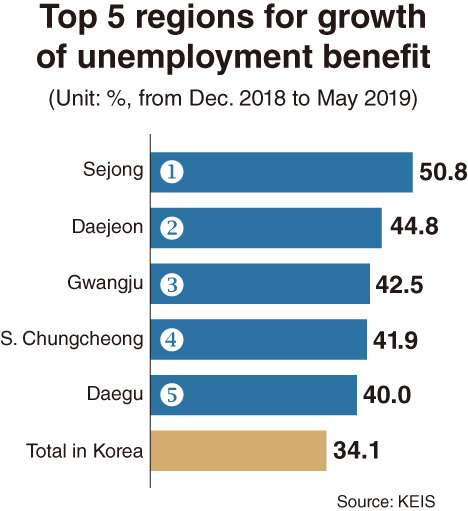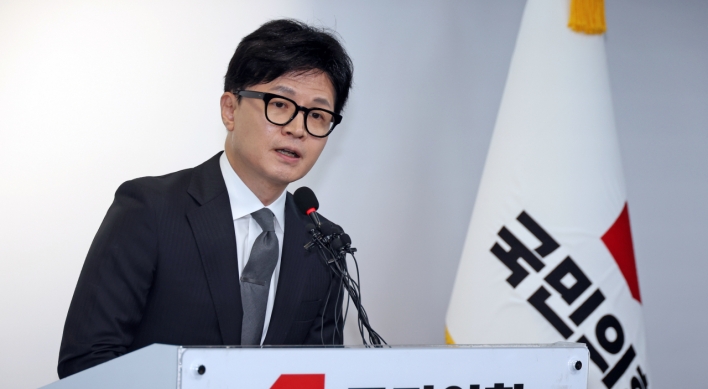[News Focus] Payments for jobless soar in Daejeon, Gwangju, Daegu
By Kim Yon-sePublished : July 2, 2019 - 16:34
SEJONG -- The nation’s jobless rate, which posted the critical 4 percent or over for the fifth consecutive month this year, has forced the government to pay out ever-higher amounts in benefits for the unemployed.
The growing volume of payouts reflects the sentiment-reflected jobless rate, a measure that also takes underemployment into account. The sentiment-reflected jobless rate far exceeds the official unemployment rate of 4 percent mark, having hovered around 12 percent for the first five months of 2019. Figures for June are not yet available.
The “sentiment-reflected unemployed” include temporary employees who work fewer than 36 hours a week and want to change jobs, as well as seasonal workers who are out of work for part of the year.
According to the Korea Employment Information Service, the number of people receiving unemployment benefits reached 512,158 in May 2019. This marked a 34.1 percent increase, or more than 130,000 people, compared with the end of 2018. The number of unemployment allowance recipients recorded 381,706 in December.
The growing volume of payouts reflects the sentiment-reflected jobless rate, a measure that also takes underemployment into account. The sentiment-reflected jobless rate far exceeds the official unemployment rate of 4 percent mark, having hovered around 12 percent for the first five months of 2019. Figures for June are not yet available.
The “sentiment-reflected unemployed” include temporary employees who work fewer than 36 hours a week and want to change jobs, as well as seasonal workers who are out of work for part of the year.
According to the Korea Employment Information Service, the number of people receiving unemployment benefits reached 512,158 in May 2019. This marked a 34.1 percent increase, or more than 130,000 people, compared with the end of 2018. The number of unemployment allowance recipients recorded 381,706 in December.

While the number of unemployment allowance recipients has surged in eight major cities and nine provinces across the country, Sejong, where the government complex is located, topped the list with an increase of 50.8 percent -- from 1,750 to 2,639 people -- over the cited period. Sejong is the nation’s fastest-growing city in terms of population.
Daejeon ranked second with a 44.8 percent increase (from 10,674 to 15,458 people), followed by Gwangju at 42.5 percent (from 9,745 to 13,893), South Chungcheong Province at 41.9 percent (from 12,047 to 17,104) and Daegu at 40.0 percent (from 17,933 to 25,121).
A labor market analyst in Seoul said, “Compared with the Seoul Metropolitan Area, self-employed businesspeople including food retailers in other metropolitan cities are thought to have taken a tougher hit from the economic slowdown and (the Moon Jae-in government’s) drastic hikes in the minimum wage.”
Seoul and Gyeonggi Province saw the number of recipients climb from 72,624 and 97,518 to 95,883 and 130,721, respectively. For Seoul, this represents a 32.0 percent increase; for Gyeonggi Province, it is 34.0 percent.
People in their 50s made up the highest proportion of those on benefits at 25.1 percent. Those in their 60s were next at 21.2 percent, followed by those in their 40s at 20.3 percent, those in their 30s at 19.6 percent and those in their 20s at 13 percent.
Women outnumbered men among eligible claimants during May, accounting for 52.3 percent of the total.
According to government data, there was a sharp increase in the number of claimants among those who had recently worked in the construction and lodging and restaurant sectors.
An official with the Ministry of Employment and Labor cited massive business closures in the lodging and food sector as the main reason. The ratio of business closures to startups in this sector recently posted about 80 percent.
The total amount paid out in unemployment benefits came to 788.7 billion won ($678.1 million) in May 2019, up 60.2 percent from 492.3 billion won in December 2018, data from the Korea Employment Information Service showed.
Benefits paid to recipients in Gyeonggi Province stood at the highest level nationwide at 201.6 billion won. In this regard, Gyeonggi Province was followed by Seoul at 146.5 billion won with Busan coming in third at 61.5 billion won.

Some government officials say the surge in benefit payments corresponded, more or less, to increases in the statutory minimum wage, which shot up 29 percent in only two years.
The Labor Standards Act stipulates that unemployment allowance payments must not fall below 90 percent of the minimum wage.
Whereas the average recipient was paid 1.18 million won per month in 2017, the average monthly payment surged to 1.51 million won in 2019, according to a release from the Employment Ministry.
Meanwhile, South Korea saw the number of jobless people reach 1.145 million as of May. This is a 15 percent increase during President Moon’s term -- since May 2017, when he took office and when the number of unemployed people posted 995,000.
The sentiment-reflected jobless rate was 10.9 percent in May 2017. The figure rose to 11.5 percent in December 2018 and 12.1 percent in May 2019, according to Statistics Korea.
Since 2015, Statistics Korea has compiled sentiment-reflected unemployment rates in a document titled the Supplementary Index III for Employment, an effort to shed a clearer light on unemployment and underemployment trends.
By Kim Yon-se (kys@heraldcorp.com)



![[Exclusive] Korean military set to ban iPhones over 'security' concerns](http://res.heraldm.com/phpwas/restmb_idxmake.php?idx=644&simg=/content/image/2024/04/23/20240423050599_0.jpg&u=20240423183955)

![[Graphic News] 77% of young Koreans still financially dependent](http://res.heraldm.com/phpwas/restmb_idxmake.php?idx=644&simg=/content/image/2024/04/22/20240422050762_0.gif&u=)



![[Pressure points] Leggings in public: Fashion statement or social faux pas?](http://res.heraldm.com/phpwas/restmb_idxmake.php?idx=644&simg=/content/image/2024/04/23/20240423050669_0.jpg&u=)









